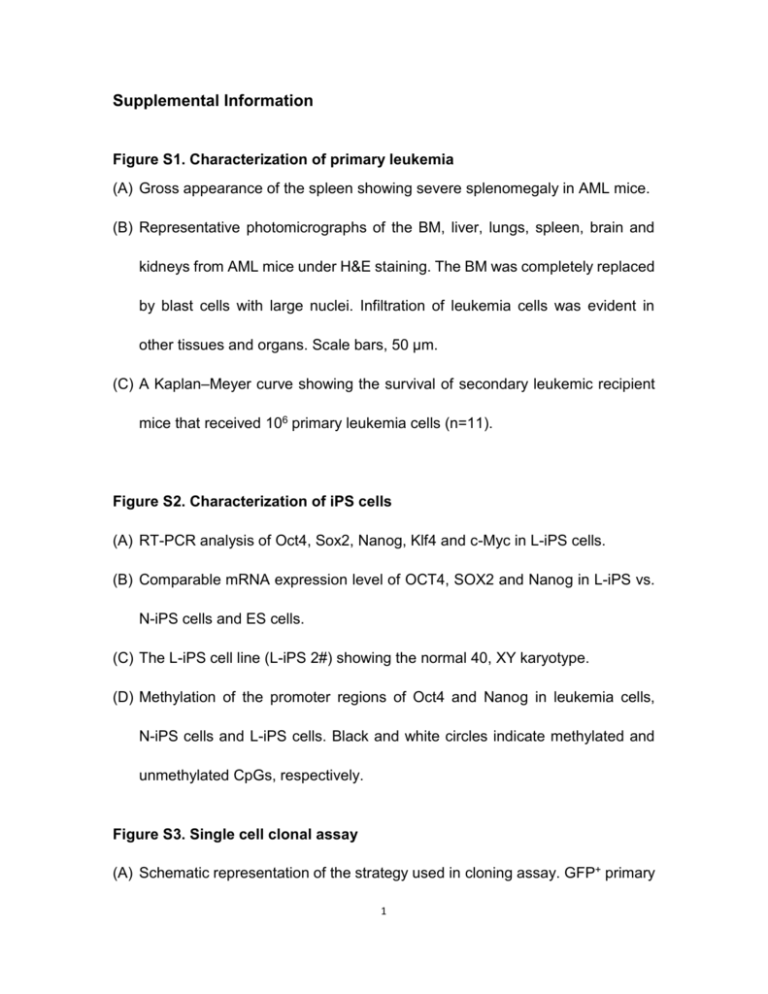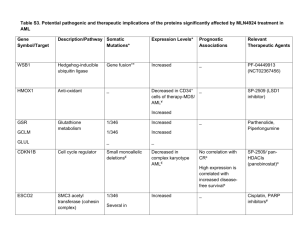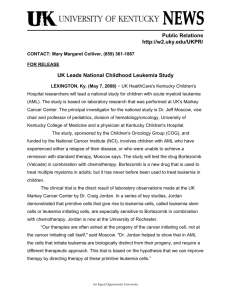Supplementary Information (doc 66K)
advertisement

Supplemental Information Figure S1. Characterization of primary leukemia (A) Gross appearance of the spleen showing severe splenomegaly in AML mice. (B) Representative photomicrographs of the BM, liver, lungs, spleen, brain and kidneys from AML mice under H&E staining. The BM was completely replaced by blast cells with large nuclei. Infiltration of leukemia cells was evident in other tissues and organs. Scale bars, 50 μm. (C) A Kaplan–Meyer curve showing the survival of secondary leukemic recipient mice that received 106 primary leukemia cells (n=11). Figure S2. Characterization of iPS cells (A) RT-PCR analysis of Oct4, Sox2, Nanog, Klf4 and c-Myc in L-iPS cells. (B) Comparable mRNA expression level of OCT4, SOX2 and Nanog in L-iPS vs. N-iPS cells and ES cells. (C) The L-iPS cell line (L-iPS 2#) showing the normal 40, XY karyotype. (D) Methylation of the promoter regions of Oct4 and Nanog in leukemia cells, N-iPS cells and L-iPS cells. Black and white circles indicate methylated and unmethylated CpGs, respectively. Figure S3. Single cell clonal assay (A) Schematic representation of the strategy used in cloning assay. GFP+ primary 1 leukemia cells were flow sorted and plated in semisolid medium for 7 days. Individual AML colonies were plucked from semisolid culture and re-plated once, and then, after additional 5 days, cells from single colonies were washed and pooled for secondary transplantation and iPS assay. When the secondary recipients developed leukemia, GFP+ cells were isolated and separated for leukemia development and iPS induction (the reprogramming procedure is the same as described in Figure 2A). (B) Bright-field images of representative AML colonies in 1st and 2nd plating. Scale bars, 100 μm. (C) The list of 7 AML colonies selected for iPS formation and leukemia development. + or -, Yes or No. (D) FACS analysis of bone marrow cells isolated from leukemia mouse (colony 5#) showing the GFP+Mac-1+Gr-1+CD3-B220- phenotype. (E) Representative an iPS colony derived from 5# AML colony cells cultured with Dox and typical morphology of iPS cells after propagation. Scale bars, 100 μm. (F) Immunofluorescence staining showing the expression of pluripotency markers (OCT4, SOX2, NANOG and SSEA1) in L-iPS cells. The data represent 1 of 3 independent experiments. Scale bars, 20 μm. 2 (G) GFP+ transformed leukemia cells from secondary leukemic mice initiated by 4# and 5# colony cells were able to give rise to iPS and leukemia. + or -, Yes or No. (H) A Kaplan–Meyer curve showing the survival of tertiary recipient mice (n=7,8). Figure S4. Leukemia development in chimeric mice (A) Representative peripheral blood smear (Wright-Giemsa staining) from a chimeric mouse with signs of illness, showing immature myeloid blast cells in the circulatory system. (B) Representative photographs of the spleen in chimeric mice with leukemia vs. normal mice. (C) Representative histological sections of the BM, liver, lungs, spleen, kidneys and brain in chimeric mice with leukemia. H&E staining. Scale bars, 50 μm. (D) Cytospin of BM cells showing the presence of immature blast cells in chimeric mice. Scale bars, 10 μm. Figure S5. Silence of the leukemogenic gene in the iPS cells (A) RNA-seq result showing the MLL-AF9 fusion gene expression in different types of cells. MLL-AF9 was only expressed in leukemia cells. (B) RT-PCR analysis of peripheral blood of chimeras showing that the MLL-AF9 fusion gene could be detected as early as one month after birth. 3 Figure S6. Enrichment of MLL-AF9 signature genes in P4 and P5 (A-B) GSEA plots revealing that expression of MLL-AF9 signature genes were enriched in the P4-down and P5-up (A), while the reverse enrichment was observed in P4-up and P5-down (B). Figure S7. Reprogramming of ICN1-overexpressed cells (A) Morphology (Left panel, 40 x magnification; Right panel, 100 x magnification) of ES-like colonies induced from T-ALL cells. The procedure is identical to reprogramming AML cells. MSCV-ICN1-IRES-GFP was used to transform HSPCs to leukemia cells. GFP (or ICN1) was not silenced in ES-like colonies, suggesting that the leukemia cells were partially reprogrammed. The colonies cannot be passaged successfully. Scale bars, 100 μm. (ICN1: intracellular domain of Notch1 ) (B) AP staining of ES-like colonies induced from ICN1-overexpressed MEF cells. MEF cells were infected with GFP vector or ICN1 and 4 ‘Yamanaka factors’, and cultured in the ES medium. (C) Colony formation of ICN1-overexpressed MEF cells, relative to the control. The result indicates that ICN1-overexpression reprogramming. Bars represent Mean ± S.D. 4 could suppress the Table S4. RT-PCR primers Gene Sequence (5’-3’) Forward Reverse Gapdh CGGAGTCAACGGATTTGGTCGTAT AGCCTTCTCCATGGTGGTGAAGAC Sox2 GCGGAGTGGAAACTTTTGTCC CGGGAAGCGTGTACTTATCCTT Oct4 GAAGCAGAAGAGGATCACCTTG TTCTTAAGGCTGAGCTGCAAG Nanog CCTCAGCCTCCAGCAGATGC CCGCTTGCACTTCACCCTTTG Klf4 TGATGGTGCTTGGTGAGTTG TTGCACATCTGAAACCACAG c-Myc TCTCCATCCTATGTTGCGGTC TCCAAGTAACTCGGTCATCATCT AACCACCTCCGGTCAATAAGC TTCACGATCTGCTGCAGAATG MLL-AF9 Table S5. Real-time PCR primers Gene Sequence of primers (5’-3’) Forward Reverse Oct4 ATCACTCACATCGCCAATCA TGGGAAAGGTGTCCCTGTAG Nanog AAGCCACTAGGGAAAGCCAT GGAAGAAGGAAGGAACCTGG Sox2 AAGGGTTCTTGCTGGGTTTT AGACCACGAAAACGGTCTTG Gapdh CGGAGTCAACGGATTTGGTCGTAT AGCCTTCTCCATGGTGGTGAAGAC MLL-AF9 AACCACCTCCGGTCAATAAGC 5 TTCACGATCTGCTGCAGAATG Table S6. Two-round nested PCR primers Gene Sequence (5’-3’) Forward Reverse Oct4-outside GAGGATTGGAGGTGTAATGGTTGTT CTACTAACCCATCACCCCCACCTA Oct4-inside TGGGTTGAAATATTGGGTTTATTT CTAAAACCAAATATCCAACCATA Nanog-outside AAGTATGGATTAATTTATTAAGGTAGTT AAAAAACCCACACTCATATCAATATA Nanog-inside AAGTATGGATTAATTTATTAAGGTAGTT CAACCAAATAACCTATCTAAAAA MLL-AF9 TGTAGGTTTGGTAAGTTAGTTTAAGT CTTTTATTAAACTCRAAAAACAAA CGGTTTAGGGTTAAGAATAGATGG CACTCAAAAAAAACCCTCCCAA outside MLL-AF9 inside 6






